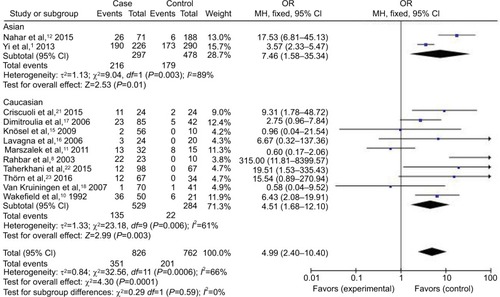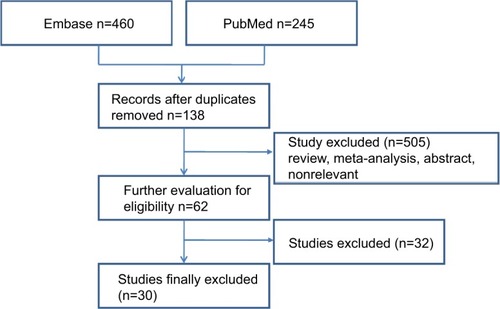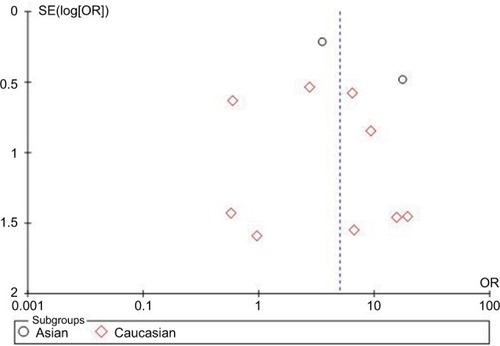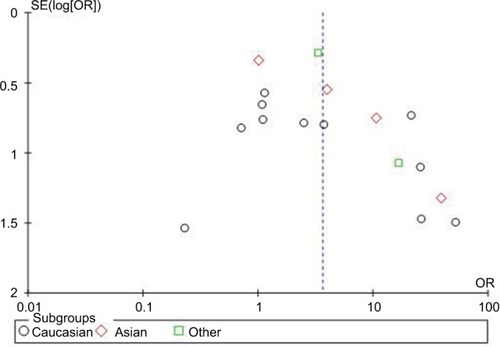Abstract
Background
Human cytomegalovirus (HCMV) infection has been associated with inflammatory bowel disease (IBD). Numerous studies have been conducted to analyze the association between HCMV infection and risk of IBD and steroid-resistant IBD, but no clear consensus had been reached.
Objectives
The aim of this study was to confirm this relationship precisely by doing a systematic review and meta-analysis.
Study design
We identified relevant studies through a search of PubMed and Embase. Studies were eligible for inclusion if they 1) evaluated the association between HCMV infection and IBD disease; 2) evaluated the association between HCMV infection and steroid-resistant IBD disease; 3) were case–control studies or nested case–control studies; 4) provided the numbers (or percentage) of positivity for HCMV infection in cases and controls, respectively. Data were extracted and analyzed independently by two investigators.
Results and conclusion
A total of 18 studies including 1,168 patients and 951 health groups was identified, and HCMV infection was distinctly confirmed as a risk factor for the occurrence and development of IBD. When involving 17 studies including 1,306 IBD patients, a total of 52.9% of patients in the cytomegalovirus (CMV)-positive groups were observed to have steroid resistance, compared with 30.2% of patients in the CMV-negative groups. There was a significant difference in the risk of steroid resistance between people exposed to HCMV infection and those not exposed HCMV infection in IBD patients. This meta-analysis suggested that HCMV infection is associated with an increased risk for IBD and steroid-resistant IBD.
Background
Inflammatory bowel disease (IBD) is a group of chronic inflammatory diseases of the gastrointestinal tract with no specific etiology, and it includes ulcerative colitis and Crohn’s disease, and other chronic, nonspecial inflammatory diseases of the gut with unknown etiology. The diagnosis is based on clinical, radiological, endoscopic, and histopathological studies. Several attempts have been made to uncover a possible infectious agent as a cause of IBD. But to date, such efforts have failed to prove any suspected pathogen.
Even though the etiology of IBD is unknown, recent studies have shown that the pathogenesis of IBD is related to susceptible genes, immune dysregulation, and microbiota of the gut.Citation1 IBD is characterized by alternating phases of exacerbation and remission, and cytomegalovirus (CMV) infection is one prominent cause of exacerbation. In addition, CMV infection is an emerging and controversial complication in patients with IBD.Citation2 There are many case reports which suggest that IBD patients are particularly vulnerable to CMV infection.
CMV is a β herpes virus with double-stranded DNA. Worldwide, the current infective rate ranges between 40% and 100%. CMV infection is a type of opportunistic infection, as the virus is reactivated and results in active CMV infection with characteristics of viremia and visceral injury (for example pneumonia or colitis) in immunocompromised patients. During the past few decades, abundant observational research has produced data on CMV prevalence in patients with IBD.Citation3 Accordingly, previous studies recommended that CMV infection be suspected in IBD patients with resistance to steroid treatment.Citation4 However, it is still uncertain whether CMV infection has an active role in IBD or whether it exists coincidentally.
The prevalence of CMV can be assessed in several ways. Serological CMV IgG testing provides data about latent infection, while IgM testing provides information on recent infection or, as is more likely in adults, reactivation. Other techniques used to demonstrate the virus include immunohistochemistry with antibodies to CMV early antigen or pp65, in situ hybridization to detect CMV mRNA, and polymerase chain reaction (PCR) for CMV DNA,Citation5,Citation6 and each has been used to attempt to quantify the infection.
The aims of this study were to clarify the association between CMV infection and IBD and to identify the relationship between CMV infection and steroid-resistant IBD.
Study design
Search strategy
We searched PubMed and Embase and for eligible studies to include in the present meta-analysis, using the terms “human cytomegalovirus” and “inflammation bowel disease” or “Crohn’s disease” or “ulcerative colitis.” An upper date limit of June 10, 2017 was applied; we used no lower date limit. Papers published in English were included. We reviewed citations in the retrieved papers to search for additional relevant studies. The retrieved studies were then read in their entirety to assess their appropriateness for the inclusion in this meta-analysis.
Inclusion/exclusion criteria
Studies were eligible for inclusion if they 1) evaluated the association between human cytomegalovirus (HCMV) infection and IBD; 2) evaluated the association between HCMV infection and steroid-resistant IBD; 3) were case–control studies or nested case–control studies; 4) and provided the numbers (or percentage) of positivity for HCMV infection in cases and controls, respectively. Conference abstracts, case reports, editorials, review articles, and letters were excluded.
Search selection and data extraction
Two authors (Ya-li Lv and Fei-fei Han) extracted data and reached a consensus on all of the eligibility items according to the aforementioned inclusion criteria. The following data were collected from each study: first author’s surname, the year of publication, source of cases, HCMV detection method, total numbers of cases and controls, and the positivity for HCMV infection in cases and controls or the incidence of steroid resistance in HCMV positive and negative patients, respectively.
All articles reporting data for HCMV prevalence based on enzyme-linked immunosorbent, PCR detection methods, and immunohistochemistry with antibodies to CMV early antigen or pp65 since April 12, 1975, were selected.
Statistical analysis
All statistical analyses were performed using Review Manager (Review Manager 5.0 software; Cochrane, London, England, UK) and Stata/MP 11.0. Cochran’s w2 test and the inconsistency index (I2) were used to evaluate heterogeneity across the included studies. Random-effects model was applied in all the analysis. Odds ratio (OR) and corresponding 95% confidence intervals (CIs) were estimated. Z-test was performed to determine the statistical significance of pooled OR, and was considered significant when P<0.05. Statistical heterogeneity test was performed by using the χ2 and I2 statistics, and I2 value of more than 50% was considered as substantial heterogeneity.Citation7
Results
Search results
Our search identified 705 potentially relevant studies, 30 of which met the predefined study criteria and were included in our meta-analysis. summarizes the process of study identification, inclusion, and exclusion. There were 245 abstracts from the PubMed search and 460 articles from Embase search. After duplicates were removed, 667 records were assessed for eligibility, and 30 records were finally included in the analysis.Citation1,Citation3,Citation8–Citation35
Characteristics of included studies
The characteristics of included studies and patients are presented in , including 18 studies, and including 17 researches; there were 5 duplicates studies among these, so 30 records were included in the final analysis. shows the characteristics and variables collected for the prevalence of CMV infection in IBD disease. And displays the characteristics of the relationship between CMV infection and steroid-resistant IBD.
Table 1 Main characteristics of the studies included in the meta-analysis
Table 2 Main characteristics of the relationship between CMV infection and steroid-resistant IBD
As shown in , data were available for a total of 1,168 patients and 951 healthy people; containing 14 studies from a Caucasian subgroup, 2 from an Asian subgroup, and 1 from a subgroup of other ethnicities. As can be seen in , data were available for a total of 1,306 patients, containing 11 studies from a Caucasian subgroup, 4 from an Asian subgroup, and 2 from a subgroup of other ethnicities.
Risk of CMV infection in patients with IBD
Meta-analysis results
A meta-analysis of 18 studies is reported in and –, dealing with the association between HCMV infection and IBD disease. When involving 18 studies including 1,168 patients and 951 health groups, a total HCMV positive ratio of 69.6% in IBD patients (247/352) and 51.82% in control groups (171/330) based HCMV IgG tests, 5.5% in IBD patients (18/325) and 0.59% in control groups (28/895) based HCMV IgM tests, 42.5% in IBD patients (351/826) and 26.4% in control groups (201/762) based HCMV DNA tests, 48.8% in IBD patients (79/162) and 10.3% in control groups (12/116) based on HCMV immediate-early (IE) tests, and 40.4% in IBD patients (92/228) and 6.6% in control groups (8/121) based on HCMV pp65 tests was observed.
Figure 2 Forest plot (random-effect model) of the association between HCMV infection and IBD stratified by the study design based on HCMV IgG tests.
Abbreviations: CI, confidence interval; HCMV, human cytomegalovirus; IBD, inflammatory bowel disease; MH, Mantel–Haenszel; OR, odds ratio.

Figure 3 Forest plot (random-effect model) of the association between HCMV infection and IBD stratified by the study design based on HCMV IgM tests.
Abbreviations: CI, confidence interval; HCMV, human cytomegalovirus; IBD, inflammatory bowel disease; MH, Mantel–Haenszel; OR, odds ratio.

Figure 4 Forest plot (random-effect model) of the association between HCMV infection and IBD stratified by the study design based on HCMV DNA tests.
Abbreviations: CI, confidence interval; HCMV, human cytomegalovirus; IBD, inflammatory bowel disease; MH, Mantel–Haenszel; OR, odds ratio.

Figure 5 Forest plot (random-effect model) of the association between HCMV infection and IBD stratified by the study design based on HCMV IE tests.
Abbreviations: CI, confidence interval; HCMV, human cytomegalovirus; IBD, inflammatory bowel disease; IE, immediate-early; MH, Mantel–Haenszel; OR, odds ratio.

Figure 6 Forest plot (random-effect model) of the association between HCMV infection and IBD stratified by the study design based on HCMV pp65 tests.
Abbreviations: CI, confidence interval; HCMV, human cytomegalovirus; IBD, inflammatory bowel disease; MH, Mantel–Haenszel; OR, odds ratio.

Compared with the control groups, people exposed to HCMV infection had higher risk than those not exposed to CMV. The ORs of HCMV infection rate in IBD patients compared to the control groups were, respectively, 7.14 [95% CI =1.58–32.25, p=0.01] based on HCMV IgM tests, 4.99 [95% CI =2.40–10.40, p<0.0001] based on HCMV DNA tests, 8.43 [95% CI =4.08–17.42, p<0.00001] based on HCMV IE tests, and 7.44 [95% CI =3.12–17.76, p<0.00001] based on HCMV pp65 tests. However, there was no difference in the risk of HCMV infection rate in IBD patients compared to the control groups based on HCMV IgG tests [OR =1.36, 95% CI =0.45–4.14, p=0.59].
Subgroup analysis
In the stratified analysis by ethnicity, through the experimental results (), HCMV infection was distinctly confirmed as a risk factor for the occurrence and development of IBD in Asian and Caucasian groups based on HCMV DNA tests, with ORs of 7.46 [95% CI =1.58–35.34, p=0.01] and 4.51 [95% CI =1.68–12.10, p=0.003], respectively.
Risk of CMV infection in patients with steroid-resistant IBD
Meta-analysis results
When involving 17 studies including 1,306 IBD patients, a total of 52.9% of patients in the CMV-positive groups were observed to have steroid resistance, compared with 30.2% of patients in the CMV-negative groups. There was a significant difference in the risk of steroid resistance between people exposed to HCMV infection and those not exposed HCMV infection for IBD patients [OR =3.63, 95% CI =1.99–6.62, p<0.0001].
Subgroup analysis
In the stratified analysis by ethnicity and CMV detection method, HCMV infection was distinctly confirmed as a risk factor for the occurrence of steroid-resistant IBD through the experimental results ().
Table 3 Main characteristics of the studies included in the meta-analysis
Sensitivity analysis
The purpose of sensitivity analysis is to estimate the stability of the results. When any single study was omitted, the pooled results showed a lack of change. This means that in the overall meta-analysis, no single study substantially affected the stability of the results. Therefore, the results of this meta-analysis were stable and reliable.
Publication bias
The publication bias of the included studies was investigated with the Begg’s funnel plot and Egger’s test. The results are presented in and . The shapes of the funnel plots showed some dissymmetry. Egger’s test was used to provide statistical evidence of funnel plot symmetry, and there was no evidence of publication bias.
Discussion
CMV is an opportunistic pathogenic microorganism that was discovered in immunocompetent individuals in the 1960s. As a β-herpesvirus, it is an important pathogen in many patients and widely exists in the majority of the population. After primary infection, the virus persists in the body and is located mainly in white blood cells and endothelial cells. CMV also has wide tissue tropism and is able to infect multiple organs, including the intestine.Citation36 CMV was first found to be related with IBD in 1961.Citation37 Since then, research on the effect of CMV infection on IBD activation has attracted broad attention and interest among clinicians. In IBD patients, immunosuppressive therapy, impaired absorption of nutrients, and dysfunction of the immune system render them susceptible to CMV infection.Citation38 However, the role of CMV infection in patients with IBD is not confirmed yet. This meta-analysis sought to address unresolved debate regarding the relationship between CMV infection and IBD, especially CMV infection and steroid-resistant IBD.
When analyzing the relationship between CMV infection and IBD, our meta-analysis involved 19 studies including 1,218 patients and 972 healthy groups. Compared with the control groups, people exposed to HCMV infection had higher risk than those not exposed to CMV. Among 19 included studies, anti-CMV IgG, IgM, DNA, IE, and pp65 were used to detect CMV infection in IBD patients and healthy controls. Compared to the control groups, anti-CMV IE and pp65 were significantly higher in IBD patients, and the ORs of HCMV infection rate in IBD patients were, respectively, 8.43 [95% CI =4.08–17.42, p<0.00001] and 7.44 [95% CI =3.12–17.76, p<0.00001]. This suggested that CMV infection might be nearly 7~8 times higher in IBD patients than in control groups, thereby indicating the association between IBD and CMV. Our results are in agreement with the previous reportsCitation39,Citation40 suggesting that immunosuppressive medications might be an important risk factor for CMV infection. Significant heterogeneity of HCMV prevalence was noted when analyzed by ethnic subgroup. Our findings indicated that HCMV infection in Asia was the highest. Positive rates in Asian studies were 72.7% in the IBD population and 37.4% in the control population based on HCMV DNA tests, which might be the cause of the increased risk of IBD in the Asian population. However, there are limited included studies and insufficient participants in our research, so it needs further study in order to validate the relationship between ethnic difference and HCMV infection in IBD risk.
When analyzing the relationship between CMV infection and steroid resistance in IBD patients, our meta-analysis involved 17 studies including 1,306 IBD patients. Compared to CMV-negative groups, the OR in CMV-positive groups was 3.63 [95% CI =1.99–6.62, p<0.0001], which suggested that CMV infection might cause an approximately fourfold risk of steroid resistance in IBD patients. When analyzed by ethnic subgrouping, the percentage of steroid-resistant patients in the CMV-positive groups was higher than in the CMV-negative groups regardless of the ethnicity. And when analyzed by CMV detection method, the percentage of steroid resistance in CMV-positive groups was also higher than that in CMV-negative groups for the majority of the CMV detection methods. These results thus showed a positive correlation between CMV infection and steroid resistance in IBD patients. Previous studies have also reported that local reactivation of CMV is closely related with severe and steroid-refractory IBD in patients.Citation3,Citation41,Citation42
Previous studies had linked CMV infection with IBD and its resistance to steroids; however, those researches failed to provide a strong and systematic relationship between CMV infection and IBD.Citation1,Citation34,Citation42 In this research, we carried out a systematic meta-analysis assessing the effect of CMV infection on IBD and its resistance to steroids. Our results showed that there exists a significant association between CMV infection with IBD and its resistance to steroids. However, our study has several limitations. First, the number of articles included in this research is relatively small, ie, there were only 33 studies. Second, there have been some differences in the method of CMV detection and protocol, this may be because we only included published studies and did not include unpublished ones. An additional limitation in this research may be that there is a potential publication bias. In order to provide a more precise estimation on the basis of adjustment for confounders, more well-designed studies should be performed. Further prospective controlled trials will help to confirm these findings and identify subgroups of patients who might suffer from CMV infection.
In summary, our meta-analysis strongly suggests that CMV infection might be a probable cause of IBD and its resistance to steroids.
Author contributions
All authors contributed toward data analysis, drafting and critically revising the paper and agree to be accountable for all aspects of the work.
Acknowledgments
This study was supported by the Beijing Natural Science Foundation (grant nos. 7151004 and 7153165) and Natural Science Foundation of China (grant nos. 81500336). Thanks are due to Zhuoling An, Song Yang, Lingling Xuan, and Wen Zhang for drafting the article and revising it critically for important intellectual content.
Disclosure
The authors report no conflicts of interest in this work.
References
- YiFZhaoJLuckheeramRVThe prevalence and risk factors of cytomegalovirus infection in inflammatory bowel disease in Wuhan, Central ChinaVirol J2013104323374225
- LawlorGMossACCytomegalovirus in inflammatory bowel disease: pathogen or innocent bystander?Inflamm Bowel Dis20101691620162720232408
- IidaTIkeyaKWatanabeFLooking for endoscopic features of cytomegalovirus colitis: a study of 187 patients with active ulcerative colitis, positive and negative for cytomegalovirusInflamm Bowel Dis20131961156116323619714
- RahierJFMagroFAbreuCSecond European evidence-based consensus on the prevention, diagnosis and management of opportunistic infections in inflammatory bowel diseaseJ Crohns Colitis20148644346824613021
- SagerKAlamSBondAChinnappanLProbertCSReview article: cytomegalovirus and inflammatory bowel diseaseAliment Pharmacol Ther201541872573325684400
- RoblinXPilletSOussalahACytomegalovirus load in inflamed intestinal tissue is predictive of resistance to immunosuppressive therapy in ulcerative colitisAm J Gastroenterol2011161120012008
- HigginsJPThompsonSGDeeksJJAltmanDGMeasuring inconsistency in meta-analysesBmj2003327741455756012958120
- RahbarABoströmLLagerstedtUMagnussonISödergerg-NauclerCSundqvistVAEvidence of active cytomegalovirus infection and increased production of IL-6 in tisseu specimens obtained from patients with inflammatory bowel diseasesInflamm Bowel Dis20039315416112792220
- VerdonkRCHaagsmaEBVan Den BergAPInflammatory bowel disease after liver transplantation: a role for cytomegalovirus infectionScand J Gastroenterol200641220521116484126
- WakefieldAJFoxJDSawyerrAMDetection of herpesvirus DNA in the large intestine of patients with ulcerative colitis and Crohn’s disease using the nested polymerase chain reactionJ Med Virol19923831831901287131
- MarszalekAMarciniakRSzkaradkiewiczAInflammatory bowel disease - is there something new in the immunological background?Folia Histochem Cytobiol201149235736221744339
- NaharSIrahaAHokamaAEvaluation of a multiplex PCR assay for detection of cytomegalovirus in stool samples from patients with ulcerative colitisWorld J Gastroenterol20152144126671267526640344
- DomènechEVegaROjangurenIAzathioprine without oral ciclosporin in the long-term maintenance of remission induced by intravenous ciclosporin in severe, steroid-refractory ulcerative colitisInflamm Bowel Dis200814101373137918452205
- SipponenTTurunenULautenschlagerINieminenUArolaJHalmeLHuman herpesvirus 6 and cytomegalovirus in ileocolonic mucosa in inflammatory bowel diseaseScand J Gastroenterol201146111324133321879802
- KnöselTScheweCPetersenNDietelMPetersenIPrevalence of infectious pathogens in Crohn’s diseasePathol Res Pract2009205422323019186006
- LavagnaABergalloMDapernoMThe hazardous burden of Herpesviridae in inflammatory bowel disease: The case of refractory severe ulcerative colitisDig Liver Dis2006381288789316931197
- DimitrouliaESpanakisNKonstantinidouAELegakisNJTsakrisAFrequent detection of cytomegalovirus in the intestine of patients with inflammatory bowel diseaseInflamm Bowel Dis200612987988416954807
- Van KruiningenHJPoulinMGarmendiaAESearch for evidence of recurring or persistent viruses in Crohn’s diseaseAPMIS2007115896296817696953
- KuwabaraAOkamotoHSudaTAjiokaYHatakeyamaKClinicopathologic characteristics of clinically relevant cytomegalovirus infection in inflammatory bowel diseaseJ Gastroenterol2007421082382917940835
- CiccocioppoRRaccaFPaolucciSHuman cytomegalovirus and Epstein-Barr virus infection in inflammatory bowel disease: Need for mucosal viral load measurementWorld J Gastroenterol20152161915192625684960
- CriscuoliVRizzutoMRGalloEOrlandoACottoneMToxic megacolon and human cytomegalovirus in a series of severe ulcerative colitis patientsJ Clin Virol20156610310625866348
- TaherkhaniRFarshadpourFMakvandiMDetermination of cytomegalovirus prevalence and glycoprotein B genotypes among ulcerative colitis patients in Ahvaz, IranJundishapur J Microbiol201582e1745825793098
- ThörnMRorsmanFRönnblomAActive cytomegalovirus infection diagnosed by real-time PCR in patients with inflammatory bowel disease: a prospective, controlled observational study*Scand J Gastroenterol20165191075108027142339
- LévêqueNBrixi-BenmansourHReigTLow frequency of cytomegalovirus infection during exacerbations of inflammatory bowel diseasesJ Med Virol201082101694170020827767
- WadaYMatsuiTMatakeHIntractable ulcerative colitis caused by cytomegalovirus infection: A prospective study on prevalence, diagnosis, and treatmentDis Colon Rectum200346Suppl 10S59S6514530660
- KambhamNVijRCartwrightCALongacreTCytomegalovirus infection in steroid-refractory ulcerative colitis: A Case-Control StudyAm J Surg Pathol200428336537315104299
- MaconiGColomboEZerbiPPrevalence, detection rate and outcome of cytomegalovirus infection in ulcerative colitis patients requiring colonic resectionDig Liver Dis200537641842315893280
- MaherMMNassarMIAcute cytomegalovirus infection is a risk factor in refractory and complicated inflammatory bowel diseaseDig Dis Sci200954112456246219093204
- CriscuoliVRizzutoMRMontalbanoLGalloECottoneMNatural history of cytomegalovirus infection in a series of patients diagnosed with moderate-severe ulcerative colitisWorld J Gastroenterol201117563363821350712
- McCurdyJDEndersFTJonesADetection of cytomegalovirus in patients with inflammatory bowel disease: where to biopsy and how many biopsies?Inflamm Bowel Dis201521122833283826273816
- CottoneMPietrosiGMartoranaGPrevalence of cytomegalovirus infection in severe refractory ulcerative and Crohn’s colitisAm J Gastroenterol200196377377511280549
- CriscuoliVCasàAOrlandoASevere acute colitis associated with CMV: A prevalence studyDigest Liver Dis20043612818820
- OrmeciACAkyuzFBaranBSteroid-refractory inflammatory bowel disease is a risk factor for CMV infectionEur Rev Med Pharm Sci2016205858865
- CiccocioppoRRaccaFScudellerLDifferential cellular localization of Epstein-Barr virus and human cytomegalovirus in the colonic mucosa of patients with active or quiescent inflammatory bowel diseaseImmunol Res201664119120326659090
- KimYSKimYHKimJSThe prevalence and efficacy of ganciclovir on steroid-refractory ulcerative colitis with cytomegalovirus infection: a prospective multicenter studyJ Clin Gastroenterol2012461515621552140
- ChoBSYahngSAKimJHImpact of cytomegalovirus gastrointestinal disease on the clinical outcomes in patients with gastrointestinal graft-versus-host disease in the era of preemptive therapyAnn Hematol201392449750423180439
- PowellRDWarnerNELevineRSKirsnerJBCytomegalic inclusion disease and ulcerative colitis; report of a case in a young adultAm J Med19613033434013737621
- PapadakisKATungJKBinderSWOutcome of cytomegalovirus infections in patients with inflammatory bowel diseaseAm J Gastroenterol20019672137214211467645
- KimYSKimYHKimJSIBD Study Group of the Korean Association for the Study of Intestinal Diseases(KASID), KoreaCytomegalovirus infection in patients with new onset ulcerative colitis: a prospective studyHepatogastroenterology2012591161098110122580660
- KishoreJGhoshalUCKrishnaniNKumarSSinghMAyyagariAInfection with cytomegalovirus in patients with inflammatory bowel disease: prevalence, clinical signifi cance and outcomeJ Med Microbiol200453Pt 111155116015496396
- AyreKWarrenBFJefferyKTravisSPThe role of CMV in steroid-resistant ulcerative colitis: A systematic reviewJ Crohns Colitis20093314114821172262
- WuXWWuLJiHZWangFYRelationship between cytomegalovirus infection and steroid resistance in inflammatory bowel disease: a meta-analysisDig Dis Sci201560113203320826031424



